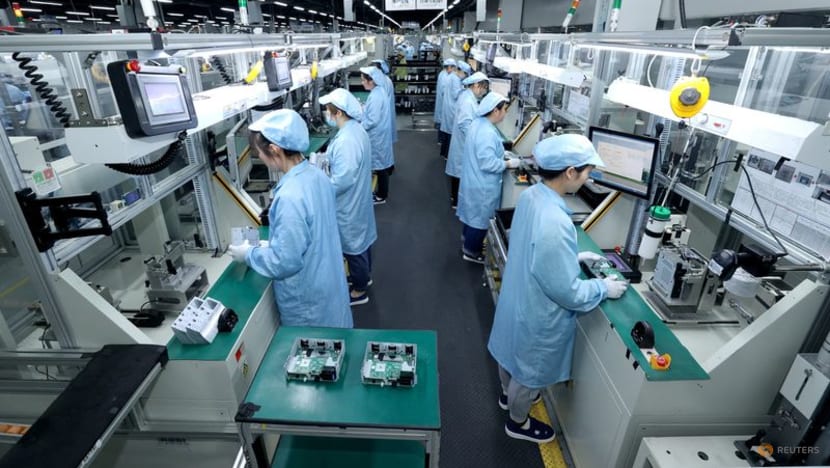China's July factory output, retail sales growth slump in blow to economic momentum

Workers work on a production line manufacturing smart automotive central control navigation products at a factory of Beidou Intelligent Connected Vehicle Technology Co. (BICV) in the High Tech Industrial Development Zone in Suqian, Jiangsu Province, China, on Apr 9, 2025. (Photo: China Daily via REUTERS)
BEIJING: China's factory output growth slumped to an eight month low in July, while retail sales also slowed sharply, reinforcing the challenge confronting policymakers as they strive to shore up an economy in the face of soft demand at home and external risks.
The underwhelming data, released by the National Bureau of Statistics (NBS) on Friday (Aug 15), come as Chinese policymakers navigate pressure on multiple fronts ranging from US President Donald Trump's trade policies to insufficient demand and excessive competition in domestic market.
Industrial output grew 5.7 per cent year-on-year in July, the lowest reading since November 2024, and compared with a 6.8 per cent rise in June. It missed forecasts for a 5.9 per cent increase in a Reuters poll.
A temporary trade truce reached between China and the United States in mid-May, which was extended by another 90-days this week, has prevented US tariff rates on Chinese goods from reaching triple-digit levels. However, Chinese manufacturers' profits continue to take a hit from subdued demand and factory-gate deflation at home.
Data released earlier this month by the NBS showed that the producer price index fell 3.6 per cent year-on-year in July, matching the near two-year low recorded in June.
Beijing has recently stepped up policy measures and made pledges to prop up domestic consumption and curb excessive price competition, as authorities strive to lift economic growth towards the government's 2025 target of around 5 per cent.
Retail sales, a gauge of consumption, expanded 3.7 per cent in July, the slowest reading since December 2024, slowing from a 4.8 per cent rise in the previous month and missing forecasts of a 4.6 per cent gain.
Fixed asset investment grew 1.6 per cent in the first seven months of the year from the same period last year, compared with an expected 2.7 per cent rise. It had expanded 2.8 per cent in the first half.
The world's second-largest economy has so far avoided a sharp slowdown in part due to policy support and as factories took advantage of the US-China trade truce to front-load shipments, but analysts say weak demand at home and global risks will drag on growth in coming quarters.
Economic activity has also been impacted by extreme weather, from record-breaking heat to storms and floods across the country, disrupting factory production and day-to-day business operations.
The latest Reuters poll projected China's GDP growth to slow to 4.5 per cent in the third quarter and 4.0 per cent in the fourth, suggesting that Beijing has its work cut out in getting households to spend more at a time of uncertainty over job security and mounting headwinds from Trump's global trade war.
China's 2025 GDP growth is forecast to cool to 4.6 per cent - falling short of the official goal - from last year's 5.0 per cent and ease even further to 4.2 per cent in 2026, according to the poll.















